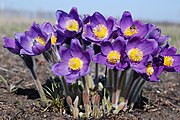Pulsatilla patens
| Pulsatilla patens | |
|---|---|

| |
| In Poland | |
| Scientific classification | |
| Kingdom: | Plantae |
| Clade: | Tracheophytes |
| Clade: | Angiosperms |
| Clade: | Eudicots |
| Order: | Ranunculales |
| Family: | Ranunculaceae |
| Genus: | Pulsatilla |
| Species: | P. patens |
| Binomial name | |
| Pulsatilla patens | |
| Synonyms[1] | |
List
| |
Pulsatilla patens is a species of flowering plant in the family Ranunculaceae, native to Europe, Russia, Mongolia, and China.[1] Common names include Eastern pasqueflower and cutleaf anemone.[2]
Taxonomy
It was first formally named in 1753 as Anemone patens[3] and is sometimes still considered part of that genus.[4] The species Pulsatilla nuttalliana, the pasqueflower native to much of North America,[5] is sometimes considered a subspecies or variety of Pulsatilla patens.[2][6]
Two subspecies are accepted:[1]
Cultural associations
Pulsatilla patens is the regional flower of the region of Tavastia Proper in Finland.[7]
- In Buryatia, Russia
- In Ukraine
References
- ^ a b c "Pulsatilla patens (L.) Mill". Plants of the World Online. Royal Botanic Gardens, Kew. Retrieved 26 April 2020.
- ^ a b Pulsatilla patens subsp. multifida USDA PLANTS database
- ^ "Anemone patens L." ipni.org. International Plant Names Index. Retrieved 26 April 2020.
- ^ "Anemone patens". Germplasm Resources Information Network. Agricultural Research Service, United States Department of Agriculture. Retrieved 2017-12-24.
- ^ "Pulsatilla nuttalliana (DC.) Spreng". Plants of the World Online. Royal Botanic Gardens, Kew. Retrieved 26 April 2020.
- ^ Wilhelm, Gerould; Rericha, Laura (2017). Flora of the Chicago Region: A Floristic and Ecological Synthesis. Indiana Academy of Sciences.
- ^ Leinonen, Matti, Nyberg, Teuvo & Veistola, Simo: Koulun biologia: Metsät ja suot. Otava, 2007, p. 157.


